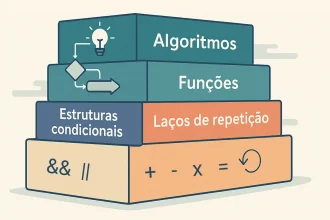In the complex universe of computer science and software engineering, the efficiency of algorithms in data structures is not merely an academic concept; it is the foundation upon which robust, scalable, and responsive systems are built. Certainly, for experts in the field, deeply understanding how and why certain algorithms perform better than others in specific data scenarios is fundamental. This understanding transcends simply obtaining a correct result; it lies in the ability to achieve that result using the least amount of computational resources possible, be it processing time or memory space, for example.
In other words, efficiency is the metric that separates a functional solution from an optimal one, or at least a viable one for large-scale problems. The inadequate performance of an algorithm or the wrong choice of a data structure can result in systems that become unusable with an increasing volume of data or workload. Therefore, a careful analysis of algorithm efficiency in data structures is indispensable in any specialist’s toolkit.
This article delves into the crucial aspects of this area. We will address the metrics used to quantify efficiency, explore how the selection of data structures impacts algorithmic performance, and analyze the complexity of common operations in various structures. Furthermore, we will discuss standard notations for expressing this efficiency and the inherent trade-offs in designing performant computational systems.
Why is Efficiency Crucial at the Expert Level?
For those at the forefront of technology, dealing with large volumes of data (Big Data), high-performance computing, distributed systems, artificial intelligence, or large-scale software development, the efficiency of algorithms in data structures has direct and profound implications, such as:
- Scalability: Firstly, efficient systems maintain acceptable performance even when the amount of data or the number of users grows exponentially. Inefficient systems quickly reach their limits.
- Resource Usage: Likewise, efficient algorithms consume less CPU time and less RAM, resulting in lower operational costs (especially in cloud environments) and better hardware utilization.
- User Experience: Additionally, responsive applications that process data quickly provide a superior end-user experience.
- Feasibility of Solutions: Certain complex problems only become computationally tractable with highly efficient algorithms and data structures.
- Innovation: Finally, mastering efficiency allows for the creation of new solutions and the optimization of existing technologies that would otherwise be unfeasible.
Thus, the ability to analyze, design, and implement efficient solutions is a distinctive mark of a computing specialist.
The Language of Efficiency: Asymptotic Analysis
Quantifying an algorithm’s efficiency precisely and independently of the specific machine or programming language is done through asymptotic analysis. This analysis focuses on the algorithm’s behavior as the input size (n) tends to infinity. We ignore constants and lower-order terms because what truly matters is how performance scales with increasing problem size.
The two main metrics of asymptotic analysis are:
- Time Complexity: Measures the amount of time an algorithm takes to execute as a function of the input size n. It is not time in seconds, but rather the number of basic operations performed (comparisons, assignments, memory accesses, etc.).
- Space Complexity: Measures the amount of RAM an algorithm needs to execute as a function of the input size n. This includes the space used to store the input and any auxiliary space needed during execution.
Fundamental Asymptotic Notations
To express complexity, we use standard notations:
- Big O Notation (O): Represents the upper bound (worst case) of a function’s growth. O(g(n)) means that, for a sufficiently large n, the algorithm’s complexity is at most a constant times g(n). It is the most common notation for describing an algorithm’s performance because it guarantees that the time or space will never be worse than specified for large inputs.
- Example: A linear search algorithm in an array has a time complexity of O(n) because, in the worst case (element not found or at the end), it needs to check all n elements.
- Omega Notation (Ω): Represents the lower bound (best case) of a function’s growth. Ω(g(n)) means that, for a sufficiently large n, the algorithm’s complexity is at least a constant times g(n).
- Example: Linear search has a time complexity of Ω(1) because, in the best case (element found in the first position), it takes constant time.
- Theta Notation (Θ): Represents the tight bound. Θ(g(n)) means that the algorithm’s complexity is bounded both above and below by constants times g(n) for a sufficiently large n. An algorithm is Θ(g(n)) if and only if it is O(g(n)) and Ω(g(n)).
- Example: Many comparison-based sorting algorithms have a time complexity of Θ(nlogn) in the average and worst cases.
Common Complexity Classes
Understanding complexity classes is vital:
- O(1): Constant time or space. The amount of resource does not change with the input size. Ideal.
- O(logn): Logarithmic time or space. The required resource grows very slowly with n. Typical in algorithms that repeatedly divide the problem in half (e.g., binary search).
- O(n): Linear time or space. The resource grows proportionally to the input size. Acceptable for many problems.
- O(nlogn): Linearithmic time or space. Common in efficient sorting algorithms (e.g., Merge Sort, Quick Sort). Scales well.
- O(n2): Quadratic time or space. The resource grows with the square of the input size. Becomes impractical quickly for large n. Common in algorithms with nested loops.
- O(2n): Exponential time or space. Grows extremely fast. Generally indicates that the algorithm is impractical, perhaps requiring a different approach (e.g., dynamic programming, approximation algorithms).
- O(n!): Factorial time or space. Grows faster than exponential. Rarely feasible.
Certainly, asymptotic analysis offers a powerful tool for comparing the relative performance of different algorithmic approaches as problems scale.
Fundamental Data Structures and Their Efficiency
The choice of data structure is as critical as that of the algorithm. The way data is organized directly influences the efficiency of operations that can be performed on it. Therefore, let’s analyze the efficiency of common operations in fundamental data structures:
1. Arrays
- Characteristics: Collection of elements stored in contiguous memory locations. Direct access to any element by its index.
- Efficiency of Operations:
- Access/Read (by index): O(1). The memory position is calculated directly.
- Insertion (at the end, if space is available): O(1).
- Insertion (at the beginning or middle): O(n). All subsequent elements need to be shifted.
- Deletion (from the end): O(1).
- Deletion (from the beginning or middle): O(n). All subsequent elements need to be shifted.
- Search (specific element): O(n) (linear search in the worst case). O(logn) if the array is sorted (binary search).
- Considerations: Arrays are efficient for random access and insertion/deletion at the end. However, they are inefficient for modifications requiring element shifting in the middle or beginning. Fixed size in some languages can be a limitation.
2. Linked Lists
- Characteristics: Collection of nodes, where each node contains data and a reference (or pointer) to the next node (singly linked list) or to the next and previous (doubly linked list). They do not require contiguous memory.
- Efficiency of Operations:
- Access/Read (by index): O(n). It’s necessary to traverse the list from the beginning.
- Insertion (at the beginning): O(1). Just create a new node and adjust the head reference.
- Insertion (at the end): O(n) in a singly linked list (needs to traverse to the end). O(1) in a singly linked list with a tail pointer or in a doubly linked list.
- Insertion (in the middle): O(n). It’s necessary to traverse the list to find the insertion point.
- Deletion (from the beginning): O(1). Just adjust the head reference.
- Deletion (from the end): O(n) in a singly linked list (needs to traverse to the second to last). O(1) in a singly linked list with a tail pointer or in a doubly linked list.
- Deletion (from the middle): O(n). It’s necessary to traverse the list to find the node to be removed.
- Search (specific element): O(n). It’s necessary to traverse the list.
- Considerations: Linked lists shine in insertion and deletion operations at the beginning (and end, depending on the variant), as they don’t require element shifting. On the other hand, random access and search are less efficient than in (sorted) arrays.
3. Stacks
- Characteristics: LIFO (Last-In, First-Out) structure. Main operations: push (add to top) and pop (remove from top).
- Efficiency of Operations:
- Push: O(1) (assuming efficient implementation, like a linked list or dynamic array with space).
- Pop: O(1).
- Peek (check top): O(1).
- Implementation: Can be efficiently implemented using dynamic arrays or linked lists.
4. Queues
- Characteristics: FIFO (First-In, First-Out) structure. Main operations: enqueue (add to end) and dequeue (remove from beginning).
- Efficiency of Operations:
- Enqueue: O(1) (assuming efficient implementation, like a linked list with a tail pointer or a circular array).
- Dequeue: O(1) (assuming efficient implementation).
- Implementation: Ideally implemented using a linked list (with head and tail pointers) or a circular array to ensure O(1) for both operations.
Advanced Data Structures and Their Efficiency
Moving forward, we encounter more complex structures designed to optimize specific operations, for example:
1. Trees
- Characteristics: Hierarchical structure composed of nodes connected by edges. The top node is the root.
- Common Types and Efficiency:
- Binary Search Trees (BST): Keep nodes ordered (left child < parent < right child).
- Search, Insertion, Deletion: O(h), where h is the height of the tree.
- Worst Case: If the tree degenerates into a linked list (elements inserted in order), h=n, then O(n).
- Best/Average Case: If the tree is balanced, h≈logn, then O(logn).
- Balanced Trees (AVL, Red-Black Trees): BSTs that automatically maintain logarithmic height through rotations.
- Search, Insertion, Deletion: O(logn) guaranteed in the worst case.
- Heaps (Min-Heap, Max-Heap): Complete binary trees that satisfy the heap property (the parent node’s value is greater/smaller than its children’s). Often implemented with arrays.
- Insertion: O(logn).
- Extraction (maximum/minimum): O(logn).
- Build Heap (from an array): O(n).
- Binary Search Trees (BST): Keep nodes ordered (left child < parent < right child).
- Considerations: Trees (especially balanced ones) are excellent for efficient (logarithmic) search, insertion, and deletion, making them ideal for dictionaries, sets, and priority queues.
2. Hash Tables
- Characteristics: Structure that maps keys to values using a hash function to calculate an index in an array (buckets).
- Efficiency of Operations:
- Insertion, Search, Deletion (Average Case): O(1). Assuming a good hash function that distributes keys uniformly and a reasonable load factor.
- Insertion, Search, Deletion (Worst Case): O(n). Occurs in case of severe collisions (multiple keys mapped to the same bucket) where all elements fall into the same bucket and a linked list or tree in that bucket needs to be traversed.
- Considerations: Offer constant average time performance for basic operations, which is extremely fast. However, worst-case performance can be linear, and the choice of hash function and collision resolution strategy is crucial. Space usage might be higher due to the need for reserved space in buckets.
3. Graphs
- Characteristics: Collection of vertices (nodes) connected by edges. Represent complex relationships between entities.
- Common Representations and Efficiency (for a graph with V vertices and E edges):
- Adjacency Matrix: V×V matrix where
matrix[i][j]indicates if there’s an edge between vertex i and vertex j.- Check if there’s an edge between u and v: O(1).
- Find all neighbors of v: O(V).
- Space: O(V2).
- Adjacency List: Array of linked lists, where index i in the array points to a linked list of vertex i’s neighbors.
- Check if there’s an edge between u and v: O(degree(u)).
- Find all neighbors of v: O(degree(v)).
- Space: O(V+E).
- Adjacency Matrix: V×V matrix where
- Common Graph Algorithms and Their Efficiency (examples):
- Breadth-First Search (BFS): O(V+E) (with adjacency list), O(V2) (with adjacency matrix).
- Depth-First Search (DFS): O(V+E) (with adjacency list), O(V2) (with adjacency matrix).
- Dijkstra’s Algorithm (shortest path in graphs with non-negative weights): O(ElogV) or O(E+VlogV) with a Fibonacci heap, O(V2) with a simple array.
- Floyd-Warshall Algorithm (all-pairs shortest paths): O(V3).
- Considerations: The choice of graph representation (matrix vs. list) significantly impacts the efficiency of algorithms that process it. Adjacency lists are generally more efficient for sparse graphs (few edges), while matrices can be better for dense graphs (many edges) or when quick edge checks are frequent.
Fundamental Algorithms and the Impact of Data Structure
The efficiency of algorithms in data structures is a two-way street. Therefore, the most efficient algorithm can be severely hampered by an inadequate data structure, and vice-versa. Let’s look at classic examples:
- Search Algorithms:
- Linear Search in an array/linked list: O(n). Simple, but slow for large n.
- Binary Search in a sorted array: O(logn). Requires the data structure (array) to be sorted and allow random access (O(1)). Impractical in linked lists where access is O(n).
- Search in a Balanced Binary Search Tree: O(logn) guaranteed. The tree structure enables this efficiency.
- Search in a Hash Table: O(1) on average. The hash table structure, with its mapping function, allows for this almost instantaneous access.
- Sorting Algorithms:
- Bubble Sort, Selection Sort, Insertion Sort: O(n2). Efficient for small arrays, but scale poorly.
- Merge Sort, Quick Sort: O(nlogn) on average/worst case (Merge Sort), O(nlogn) on average (Quick Sort). Efficient algorithms that work well on arrays (random access) or can be adapted for other structures, but with implications for space complexity (Merge Sort).
- Heap Sort: O(nlogn). Efficiently uses the Heap data structure.
- Data Stream Processing:
- Processing events in order of arrival: Queue (O(1) for enqueue/dequeue).
- Processing tasks with priority: Priority Queue (usually implemented with a Heap – O(logn) for insertion/extraction).
These examples clearly illustrate how the synergy between the algorithm and the data structure is vital for performance. An expert knows that it’s not enough to choose the “best” algorithm or the “best” data structure in isolation, but rather the most appropriate combination for the problem at hand and the efficiency requirements.
Trade-offs in Efficiency: Time vs. Space
Frequently, optimizing for time complexity can come at the cost of an increase in space complexity, and vice-versa. This is one of the most common and important trade-offs in algorithm efficiency in data structures.
- Examples of Trade-offs:
- Hash Tables: Offer O(1) average search time (optimal time complexity) but generally require more memory space than an array or linked list to allocate buckets and handle collisions (higher space complexity).
- Merge Sort: Has a guaranteed O(nlogn) time complexity but typically requires O(n) auxiliary space for the merging process, unlike Heap Sort (O(1) auxiliary space).
- Dynamic Programming Algorithms: Can reduce the time complexity of problems with overlapping subproblems (e.g., from exponential to polynomial) but often do so by storing the results of subproblems in tables (space trade-off).
- Database Indexes: Creating an index (usually implemented with B-trees) increases the database’s storage space but drastically reduces search time (from O(n) to O(logn) or O(1) in hash tables).
An expert must be able to analyze these trade-offs in the context of available resources (memory, processing time) and system requirements. Certainly, in embedded systems with limited memory, space optimization might be a priority. On the other hand, in high-performance systems with abundant RAM, time optimization might be more crucial.
Beyond Asymptotic Notation: Practical Considerations
While asymptotic analysis (O,Ω,Θ) is a powerful tool for understanding large-scale behavior, practical factors also influence real performance and should be considered by experts:
- Hidden Constants and Low-Order Terms: Big O notation ignores constants and lower-order terms (e.g., O(2n+5) is simply O(n)). However, for small to medium-sized inputs, these constants and terms can have a noticeable impact. An O(n2) algorithm with a very small constant might be faster than an O(nlogn) algorithm with a large constant for small values of n.
- Cache Locality: The way data is accessed in memory impacts processor cache usage. Data structures with contiguous allocation (like arrays) tend to have better cache locality than pointer-based structures (like linked lists), which can result in faster memory access in practice, even if the asymptotic access complexity is the same (e.g., traversing an array vs. traversing a linked list, both O(n), but the array might be faster in practice due to caching).
- Specific Hardware: Processor architecture, memory speed, cache structure, and other hardware factors influence the actual speed of operations.
- Programming Language and Compiler: The language used and compiler optimization can affect implementation performance.
- Operating System Load: Other running processes, CPU scheduling, and memory management by the operating system also impact actual execution time.
Thus, asymptotic analysis provides a high-level view of scalability, but practical performance analysis (profiling, benchmarking) is essential for fine-tuning and optimizations in real systems.
Tools and Techniques for Performance Analysis
Experts use various tools and techniques to evaluate and optimize the efficiency of algorithms in data structures in real systems:
- Profiling: Profiling tools measure the time spent in different parts of a program, identifying “hot spots” where the code spends most of its time. This directs optimization efforts to the most critical areas.
- Benchmarking: Involves running the algorithm or system with representative test datasets and measuring performance metrics (execution time, memory usage). This allows comparison of the performance of different implementations or algorithms under specific loads.
- Performance Unit Tests: Additionally, writing tests that verify if the performance of critical code parts remains within acceptable limits as the code evolves.
Consequently, a combination of theoretical analysis (asymptotic) and practical analysis (profiling, benchmarking) is the most effective approach to ensure algorithm efficiency in data structures in real-world systems.
The Central Role of Data Structure Choice
It’s impossible to overemphasize the impact of data structure choice. The most ingenious algorithm can be neutralized by inadequate data organization.
- For frequent insertion/deletion operations at the beginning, a linked list is superior to an array.
- For fast indexed access, an array is unbeatable.
- For fast searching in a dynamic set, balanced trees or hash tables are excellent choices, each with its trade-offs.
- For modeling complex relationships and performing traversals, graphs and their representations are essential.
An expert not only knows existing data structures but deeply understands their efficiency characteristics to choose the most suitable one for each problem. Indeed, in many cases, the most efficient solution involves the combined use of different data structures.
Conclusion: Mastering Efficiency for the Future
In conclusion, the efficiency of algorithms in data structures continues to be a fundamental pillar in computer science and software engineering, especially as we deal with ever-larger datasets and stricter performance requirements. For experts, mastering this topic is not optional; it is a necessity to design and build systems that are not only correct but also performant, scalable, and economically viable.
In this article, we explored asymptotic analysis tools, time and space complexity, and the direct impact that data structures, from the most basic to the most advanced, have on algorithmic efficiency. We discussed inherent trade-offs and the importance of considering practical factors beyond asymptotic theory.
In short, the ability to analyze algorithm efficiency in data structures, choose the right data organization tools for the task, and implement optimized solutions is what enables experts to solve today’s most challenging computational problems and build the technologies of the future. The continuous search for more efficient solutions drives innovation and defines the limit of what is computationally possible. Therefore, investing in a deep understanding of this topic is a direct investment in the ability to build the technological future.
Did you like the article Exploring Algorithm Efficiency in Data Structures? Check out more here.









